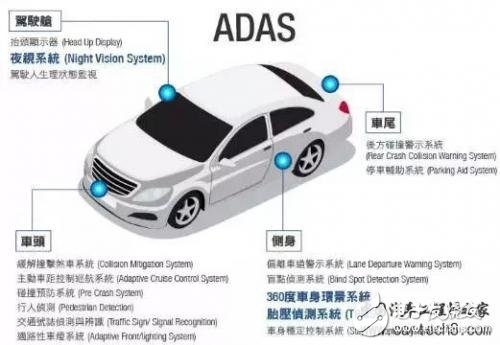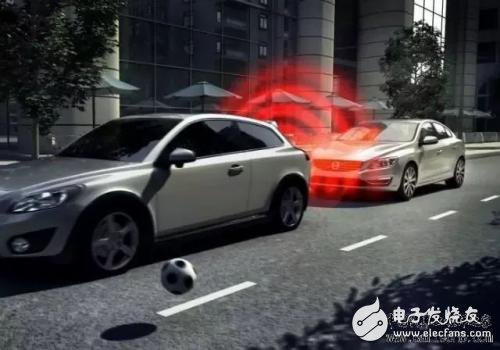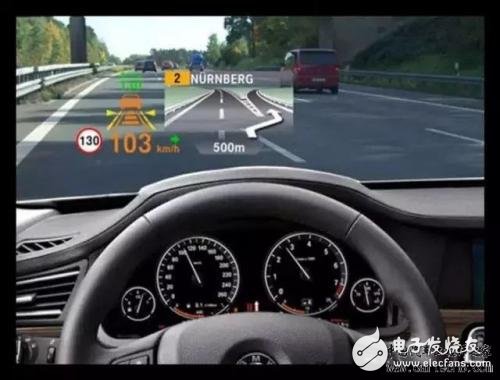"In order to realize the vision of "driving without driver," major automakers and suppliers are currently developing Advanced Driver Assistance Systems (ADAS). As ADAS is gradually improved, vehicles are also step by step from NHTSa. Exceeding to level 4 and fully automated."
ADAS (Advanced Driver Assistant System) advanced driver assistance system ADAS. More than a dozen features have been developed.

From functional classification, it can be divided into:
1. Active control class ADAS: ACC/AEB/LKS, etc.

2. Early warning ADAS: FCW/LDW/PCW, etc.
3. Other auxiliary ADAS: BSD/ADB/Panorama Parking, etc.
Let's take a look at each of the functions to see how they are implemented.
1: Adaptive Cruise Control (ACC)
The adaptive cruise control system is an intelligent automatic control system. It is based on the existing cruise control technology. During the running of the vehicle, a distance sensor (radar) installed at the front of the vehicle continuously scans the road in front of the vehicle while the wheel speed sensor collects the vehicle speed signal. When the distance from the preceding vehicle is too small, the ACC control unit can coordinate the brake anti-lock braking system with the engine control system to properly brake the wheels and reduce the output power of the engine so that the vehicle and the vehicle ahead Always maintain a safe distance.

2: Auto emergency emergency braking (AEB)
AEB is an active safety technology for automobiles. It is mainly composed of 3 modules. The core of the distance measurement module includes microwave radar, laser radar and video systems. It can provide road safety, accurate and real-time image and road condition information.
The AEB system uses a radar to measure the distance to the vehicle or obstacle, and then uses the data analysis module to compare the measured distance with the alarm distance and the safety distance. When the alarm distance is less than the alarm distance, an alarm is given. Even if the distance is less than the safety distance, In the event that the driver does not have time to step on the brake pedal, the AEB system will also start, allowing the car to brake automatically, thus escorting the car for safety.

3: Smart Headlight Controls Adaptive Front Lights (AFL)
This is a technology that can be installed in a car. It can change the direction of the headlights according to the shape of the road. Other smart headlight control systems can change the intensity of the headlight according to the speed of the vehicle and the road environment.
4: Blind Spot Monitoring (BSM)
The blind spot detection system uses anti-collision radar, Doppler radar, infrared radar and other sensors, blind spot detectors and other facilities arranged around the vehicle. It is controlled by a computer to provide the driver with necessary information in the form of sound and light (flashing of small lights on the side-view mirrors) at any time in the event of dangers such as overtaking, reversing, changing lanes, heavy fog, and rain. And can automatically take measures to effectively prevent accidents.
5: Driver Monitoring Systems (DMS)
The system uses sensors to detect the driver's attention. If the driver looks to the front of the road, and at the same time there is a crisis situation is detected. The system will use a flashing, harsh sound to warn. If the driver does not respond, the vehicle will automatically brake.

6: Forward Collision Warning (FCW)
FCW can constantly monitor the vehicle in front through the radar system and camera, determine the distance, azimuth and relative speed between the vehicle and the vehicle in front, and warn the driver when there is a potential collision risk. The FCW system itself will not take any braking measures to avoid collisions or control the vehicle.
7: Heads-Up Display (HUD)
This technology projects important information (such as the speed of the vehicle) displayed by the instrument on the front windscreen during driving, which not only helps the novice who lacks speed judgment to control his own speed, but also avoids speeding violations in many speed limit sections. And, more importantly, it enables the driver to read instantaneously under conditions in which the large field of vision does not shift, and always maintains a clear-headed state of observation.

8: Intelligent Speed ​​Adaptation (ISA)
Intelligent speed control system. The system can identify traffic signs and control the throttle according to the read-out maximum speed limit information to ensure that the driver can drive within the legal speed limit, effectively avoiding the driver's speeding behavior under unconscious conditions.
9: Lane Departure Warning (LDW)
The lane departure warning system is mainly composed of HUD head-up display, camera, controller and sensor. When the lane departure system is turned on, the camera (usually installed on the side of the body or rearview mirror) will collect the lane markings at each moment, through image processing. Get the position parameter of the car in the current lane. When detecting the car deviating from the lane, the sensor will collect the vehicle data and the driver's operating status in time, and then the controller will issue an alarm signal. The whole process is completed in about 0.5 seconds for the driver. Provide more reaction time. If the driver turns on the turn signal and changes lanes normally, the lane departure warning system will not give any hints.
Liquid Crystal Display For Home Appliances
Liquid Crystal Display For Home Appliances,High Resolution Portable Lcd Display,Refrigerator Lcd Liquid Crystal Display,Response Fast Remote Lcd Monitor
Dongguan Yijia Optoelectronics Co., Ltd. , https://www.everbestlcdlcms.com